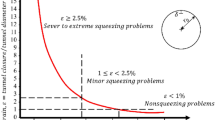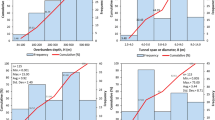Abstract
Empirical approaches play a significant part in the prediction of squeezing conditions in tunnels or caverns. On analysis of collected squeezing data from published literature, no empirical squeezing equations have been found for tunnels with a depth of more than 850 m. In this paper, an attempt has been made to generate linear classifications using rock quality index Q, rock mass number N, overburden height and tunnel span through a comparative study. 234 tunnel sections, especially of the Himalayan region, with depth up to 1900 m have been considered for the analysis. In this method, a demarcation line has been proposed to classify squeezing and non-squeezing conditions and it also allows computing probabilities of squeezing in combination with rock mass quality and tunnel depth. Further, developed equations have been compared with the existing four empirical squeezing equations in the case of the Rohtang road tunnel. The enhanced equations show better results to predict squeezing conditions for tunnels with overburden depth up to 1900 m in comparison to predictive competencies of previously existing criteria. The developed linear classifications are for deep and shallow seated tunnels in complex geological conditions using overburden height, tunnel span, rock quality index Q, and rock mass number N. The developed equations are useful for tunnel designers during the planning and support analysis of underground structures where very less physico-mechanical information are available for squeezing probability. It also suggests that the influence of tunnel depth on squeezing occurrence is a non-linear function.









Similar content being viewed by others
Data availability
Enquiries about data availability should be directed to the authors.
References
Aydan O, Akagi T, Kawamoto T (1993) The squeezing potential of rocks around tunnels; theory and prediction. Rock Mech Rock Eng 26(2):137–163
Aydan O, Akagi T, Kawamoto T (1996) The squeezing potential of rock around tunnels: theory and prediction with examples taken from Japan. Rock Mech Rock Eng 29(3):125–143
Barla G (2001) Tunnelling under squeezing rock conditions. Eurosummer-school in tunnel mechanics, Innsbruck 169–268
Barton N (2002) Some new Q-value correlations to assist in site characterisation and tunnel design. Int J Rock Mech Min Sci 39:185–216
Basarir H, Ozsan A, Karakus M (2005) Analysis of support requirements for a shallow diversion tunnel at Guledar dam site, Turkey. Eng Geol 81(2):131–145
Boidy E, Bouvard A, Pellet F (2002) Back analysis of time-dependent behaviour of a test gallery in claystone. Tunn Undergr Space Technol 17:415–424
Brantmark J, Stille H (1996) Prediction of squeezing pressure on the Uri Project, Kashmir, India. In: Proceedings. ISRM International symposium, Eurock 96. Volume 2, pp 1025–1032. Turin
Brantmark J (1998) Rock support in weak rock: a study based on the Uri project. PhD thesis, Royal Institute of Technology, Sweden
Chern JC, Yu CW, Shiao FY (1998) Tunnelling in squeezing ground and support estimation. In: Proceedings of regional symposium on sedimentary rock engineering, Taipei, pp 192–202
Choudhari JB (2007) Closure of underground opening in jointed rocks. Ph.D. thesis. Department of Civil Engineering, IIT Roorkee, Roorkee, India
Dalgic S (2002) Tunneling in squeezing rock, the Bolu tunnel, Anatolian Motorway, Turkey. Engineering Geology, Volume 67
Dube AK (1979) Geomechanical evaluation of tunnel stability under failing rock conditions in a Himalayan tunnel. Ph.D. Thesis. Department of Civil Engineering, University of Roorkee, India
Dwivedi RD, Singh M, Viladkar MN, Goel RK (2014) Estimation of support pressure during tunnelling through squeezing grounds. Eng Geol 168:9–22
Einstein HH (1996) Tunnelling in difficult ground-swelling behaviour and identification of swelling rocks. Rock Mech Rock Eng 29:113–124
Fritz P (1984) An analytical solution for axisymmetric tunnel problems in elastoviscoplastic media. Int J Numer Anal Methods Eng 8:325–342
Genis M, Basarir H, Ozarslan A, Bilir E, Balaban E (2007) Engineering geological appraisal of the rock masses and preliminary support design, Dorukhan Tunnel, Zonguldak, Turkey. Eng Geol 92(1–2):14–26
Gioda G, Cividini A (1996) Numerical methods for the analysis of tunnel performance in squeezing rocks. Rock Mech Rock Eng 4(29):171–193
Goel RK (1994) Correlations for predicting support pressures and closures in tunnels. PhD thesis, Nagpur University, India
Goel RK, Jethwa UL, Paithankar AG (1995a) Tunnelling through young Himalayas: a case history of the Maneri-Uttarkashi power tunnel. Eng Geol 39:31–44
Goel RK, Jethwa UL, Paithankar AG (1995b) An empirical approach for predicting ground condition for tunnelling and its practical benefits. In: Proceedings of 35th US Symposium on Rock Mechanics, pp 431–435
Goel RK, Jethwa UL, Paithankar AG (1995c) Indian experiences with Q and RMR systems. Tunn Undergr Space Technol 10:97–109
Guan Z, Jiang Y, Tanabashi Y (2009) Rheological parameter estimation for the prediction of long-term deformations in conventional tunnelling. Tunn Undergr Space Technol 24:250–259
Gurocak Z, Solanki P, Musharraf MZ (2007) Empirical and numerical analyses of support requirements for a diversion tunnel at the Boztepe dam site, eastern Turkey. Eng Geol 91(2–4):194–208
Hoek E (1999) Support for very weak rock associated with faults and shear zones. In: Proceedings international symposium on rock support and reinforcement practice in mining, Kalgoorlie, Australia, pp 14–19
Hoek E, Marinos P (2000) Predicting tunnel squeezing problems in weak heterogeneous rock masses. Tunnels and Tunnelling International, part one- November 2000, pages 45–51; part two – December 2000, pages 33–36
Hoek, E. (2001). The role of Experts in Tunnelling projects. Keynote address in workshop “The Tunnels of Egnatia Odos” in Ioannina, Greece.
https://geology.humboldt.edu/courses/geology531/531_handouts/equations_of_graphs.pdf
Hudson JA (2010) Stresses in rock masses: a review of key points. In: Vrkljan I (ed) Rock engineering in difficult rock conditions—soft rocks and karst. Taylor & Francis Group, London, p 61
Jain A, Rao KS (2015) Approaches for assessment and analysis of squeezing phenomenon in underground structure. In: Proceedings of international conference on engineering geology in new millennium. New Delhi, India, October 27–29
Jethwa JL, Singh B, Singh B (1984) Estimation of ultimate rock pressure for tunnel linings under squeezing rock conditions- a new approach. In: Proceedings ISRM symposium on design and performance of underground excavations, Cambridge, UK, Sept 3–4
Jethwa JL, Singh B, Bhawani S, Mithal RS (1980) Influence of geology on tunnelling conditions and deformational behaviour of supports in faulted zones: a case history of the Chhibro-Khodri tunnel in India. Eng Geol 16(3–4):291–319
Jethwa JL (1981) Evaluation of rock pressures in tunnels through squeezing ground in Lower Himalayas. Ph.D. thesis. University of Roorkee, Roorkee, India
Jimenez R, Recio D (2011) A linear classifier for probabilistic prediction of squeezing conditions in Himalayan tunnels. Eng Geol 121(3–4):101–109
Khanlari G, Meybodi RG, Mokhtari E (2012) Engineering geological study of the second part of water supply Karaj to Tehran tunnel with emphasis on squeezing problems. Eng Geol 145–146:9–17
Kockar MK, Akgun H (2003) Methodology for tunnel and portal support design in mixed limestone, schist and phyllite conditions: a case study in Turkey. Int J Rock Mech Min Sci
Kovari K, Staus J (1996) Basic considerations on tunnelling in squeezing ground. Rock Mech Rock Eng 29(4):203–210
Kumar N (2002) Rock mass characterization and evaluation of supports for Tunnels in Himalaya. PhD thesis. Department of Civil Engineering, IIT Roorkee, Roorkee, India
Malhotra VK, Tyagi GD, Sharma KS (1982) NATM for tunnel boring at Loktak H. E. Project. In: Proceedings of symposium on tunnelling, 52nd Session of the Central Board of Irrigation & Power, New Delhi, India, pp 35–58
Muirwood AM (1972) Tunnels for roads and motorways. Q J Eng GeolHydrogeol 5:111–126
Nakano R (1979) Geotechnical properties of mudstone of Neogene Tertiary in Japan. In: Proceedings of international symposium in soil mechanics, Oaxaca, pp 75–92
Nepal Electricity Authority (NEA) (2002) Project completion report. Geology and Geotechnical. Kaligandaki “A” Hydroelectric Project, Syanga, Nepal, vol. IV-A and V-C
Panet M (1996) Two case histories of tunnels through squeezing rocks. Rock Mech Rock Eng 3(29):155–164
Panthi KK, Nilsen B (2007a) Uncertainty analysis of tunnel squeezing for two tunnel cases from Nepal Himalaya. Int J Rock Mech Min Sci 44(1):67–76
Panthi KK, Nilsen B (2007b) Predicted versus actual rock mass conditions: a review of four tunnel projects in Nepal Himalaya. Tunn Undergr Space Technol 22(2):173–184
Rasouli M (2009) Engineering geological studies of the diversion tunnel, focusing on stabilization analysis and support design, Iran. Eng Geol 108(3–4):208–224
Saari K (1982) Analysis of plastic deformations (squeezing) of seams intersecting tunnels and shafts in rock. Ph.D. Thesis, University of California
Sakurai S (1983) Displacement measurements associated with the design on underground openings. In: Proceedings of international symposium on field measurements in geomechanics, pp 1163–1178
Schubert W, Grossauer K (2004) Evaluation and interpretation of displacements in tunnels. In: Proceedings 14th international conference on engineering surveying, Ingenieurvermessung 2004, ETH Zürich
Sellner PJ, Steindorfer AF (2000) Prediction of displacements in tunnelling. Felsbau 18:22–26
Shrestha GL (2005) Stress induced problems in Himalayan tunnels with special reference to squeezing. Ph.D. thesis. Department of Geology and Mineral Resources Engineering, The Norwegian University of Science and Technology (NTNU), Trondheim, Norway
Shrestha GL, Broch E (2008) Influences of the valley morphology and rock mass strength on tunnel convergence: With a case study of Khimti 1 headrace tunnel in Nepal. Tunn Undergr Space Technol 23(6):638–650
Singh B, Jethwa JL, Dube AK, Singh M (1992) Correlation between observed support pressure and rock mass quality. Tunn Undergr Space Technol 7:59–74
Singh M, Singh B, Choudhari J (2007) Critical strain and squeezing of rock mass in tunnels. Tunn Undergr Space Technol 22(3):343–350
Sripad SK, Raju GD, Singh R, Khazanchi RN (2007) Instrumentation of underground excavations at Tala hydroelectric project in Bhutan. In: Proceedings of international workshop on experiences and construction of tala hydroelectric project Bhutan, New Delhi, India, pp 269–282
Sterpi D, Gioda G (2009) Visco-plastic behaviour around advancing tunnels in squeezing rock. Rock Mech Rock Eng 42:319–339
Sulem J, Panet M, Guenot A (1987) Closure analysis in deep tunnels. Int J Rock Mech Min Sci Geomech. Abstracts 24, pp 145–154
Zhifa Y, Zhiyin W, Luqing Z, Ruiguang Z, Nianxing X (2001) Back-analysis of viscoelastic displacements in a soft rock road tunnel. Int J Rock Mech Min Sci 38:331–341
Funding
The authors have not disclosed any funding.
Author information
Authors and Affiliations
Corresponding author
Ethics declarations
Competing interest
The authors have no relevant financial or non-financial interests to disclose.
Additional information
Publisher's Note
Springer Nature remains neutral with regard to jurisdictional claims in published maps and institutional affiliations.
Supplementary Information
Below is the link to the electronic supplementary material.
Rights and permissions
About this article
Cite this article
Jain, A., Rao, K.S. Linear Classifiers for Prediction of Squeezing Conditions in Tunnels. Geotech Geol Eng 40, 4231–4246 (2022). https://doi.org/10.1007/s10706-022-02154-1
Received:
Accepted:
Published:
Issue Date:
DOI: https://doi.org/10.1007/s10706-022-02154-1




